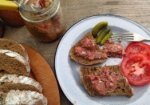One thing I love about food is that over time so much changes and at the same time so little changes.
Jared Ingersoll, 2013
Guest chef Jared Ingersoll and his mates at Studio Neon teamed up with Kate Walsh from Real Food Projects to host a truly original Farm to Table dining experience at Hyde Park Barracks as part of our feast of Eat your history programs. It was a thrill to be a part of! Jared worked really hard to ensure the food had historical integrity, working from colonial menus and heritage cookbooks, yet maintained his own style and commitment to using local, sustainable produce.
CBD BBQ
Elegant banquet tables were being stylishly dressed while Curators and heritage experts held their breaths and bit their nails as smoke billowed from the DIY fire-pits – or ‘bush barbeque’ (see images below) made on site from bricks, corrugated iron, reinforcement steel and chicken wire, which had to be moved well away from the surrounding sandstone buildings. The fire brigade soon arrived, but not on a formal call out – they were just checking out the set-up (it’s not often you experience an outdoor BBQ in the CBD).
Let the feasting begin!
The night kicked off upstairs in the old convict dormitories, with beautifully crafted edible ‘kitchen gardens’ and Eat your history‘s special brew, Young Henry’s peach braggot and beers straight from the keg. Guests proceeded into the barracks’ courtyard, to dine just metres away from the where the original convict mess-halls once stood, now the location for the Irish famine memorial. The heavens obviously approved, providing a perfectly mild and fine, starlit sky.
The menu, which was served in a series of ‘removes’ – principle dishes replacing each other in succession, while sides remained or were changed across ‘courses’ as the dinner proceeded, included:
Edible kitchen gardens, featuring produce from the kitchen garden at Vaucluse House
Kangaroo steamer, damper, cauliflower piccalilli and pickled cucumbers
Homemade Gentleman’s relish
Fish & oyster pot-pies
Coal roasted suckling pig, whole-baked pumpkins and potatoes with gravy
Eccles cakes, Pyengana cloth-bound cheddar and fresh fruit
- Photo Jacqui Newling © Sydney Living Museums
- Photo Jacqui Newling © Sydney Living Museums
- Photo Jacqui Newling
- Bringing a serving to the table. Photo © Adrian Wiggins / Pure and Applied
- Jared Ingersoll and Jacqui Newling. Photo © Adrian Wiggins / Pure and Applied
- Jared Ingersoll tells the story of the food. Photo © Adrian Wiggins / Pure and Applied
- Kate Walsh and Sioghan Toohill chatting with a guest. Photo © Adrian Wiggins / Pure and Applied
- ‘The Firepit’, Jared Ingersoll barbecuing at the Hyde Park Barrack. Photo © Adrian Wiggins / Pure and Applied
- Photo © Adrian Wiggins / Pure and Applied
The wines
Wines were generously sponsored by boutique producer James Danby Erskine from Adelaide, and Wyndham Estate, who selected their Sherpherd’s White for the occasion, due to its origins to Sydney in 1820s. Stephen Guilbaud-Oulton from Wyndham Estate came down from the Hunter Valley, where George Wyndham started his vineyard at Dalwood in the 1830s, to explain the story behind the Shepherd’s White:
In 1827 a grapevine growing in front of one of the primitive dwellings in Sydney caught the eye of an enterprising nurseryman, Thomas Shepherd. For nearly 100 years the grapes propagated from this vine bore his name, evolving from Shepherd’s White, to Shepherd’s Riesling, then Hunter River Riesling. One of the great pioneers of the Australian wine industry, George Wyndham, planted cuttings of Shepherd’s White on the banks of the Hunter River in the Spring of 1833. Now known as Semillon, wines crafted from this variety in the Hunter Valley have a unique reputation for their complexity and aging qualities.
So a big THANK YOU to Kate and Jared, and their wonderful friends, who provided such a memorable evening. Kate’s planning more exciting projects with Sydney Living Museums Eat your history including an Christmas market at Hyde Park barracks and a pop-up cooking school at Vaucluse House in February 2014. Thanks too, to Adrian Wiggins, who provided us with so many fabulous photos to document the evening.
Fish & oyster pot pie
Ingredients
- 500g firm fish fillets, skin and bones removed (eg ling or other cod)
- 12–15 fresh oysters, on shell or bottled
- 2 cups mixed vegetables, diced into 1cm cubes (eg leeks or onions, celery, potatoes, white cabbage, fennel bulbs)
- 100g streaky bacon, optional
- 2 tablespoons butter
- 2 tablespoons fresh herbs (eg tarragon, parsley, thyme)
- 1/2 teaspoon ground mace or nutmeg
- 1/2 teaspoon ground white pepper
- 1–2 sheet puff pastry
- 2 tablespoons butter, extra
- 2 tablespoons flour
- 2 lemons (one for juicing, the other cut into wedges to serve)
Note
This recipe is inspired by the large pot pies chef Jared Ingersoll served at his Farm to Table Dinner at the Hyde Park Barracks Museum in November 2013. It is typical fare that harbourside colonists might have enjoyed. It is a very forgiving recipe; you can use any combination of vegetables or seafood that you have at hand. If you don't like oysters, replace with prawns or scallops, or another type of fish – a white flesh and a pink flesh, for example. Not everyone had the luxury of an oven, but most colonists had a pot, so pot-style pies were a popular alternative to traditional pies. A dumpling-style dough was often used to form a crust instead of more delicate baked pastry. This recipe, however, uses pastry and is baked in the oven.
Directions
| Pie filling | |
| Cut the fish fillets into large bite-sized pieces (they will shrink as they cook). Remove the oysters from their shells, retaining any liquor. If using bottled oysters, strain the liquor and reserve it for the pie (optional). Refrigerate the seafood while you prepare the rest of the filling. | |
| In a large saucepan, gently sauté the vegetables and bacon, if using, in two tablespoons of butter for about 10–15 minutes, or until they are fragrant and starting to soften. Add the herbs, mace, white pepper and 3 cups water, and simmer gently until the vegetables are cooked but still firm. Drain the vegetables and set aside, reserving 2 cups of the liquid. Add salt to taste. | |
| Pie crust | |
| Preheat oven according to instructions on pastry packaging. Cut the pastry to the required size, using the rim of your pie dish or dishes as a guide. Place the pastry on baking paper, prick a few holes in it with a fork or the tip of a sharp knife, and bake in the oven until golden (refer to packaging for instructions). Remove and place on a wire rack to prevent the pastry from softening. Leave the oven on. | |
| To assemble the pies | |
| Melt the extra two tablespoons of butter in a deep saucepan. Add the drained vegetables and two tablespoons flour, stirring through the butter until the flour starts to thicken. Add the reserved stock a little at a time, stirring through until a thickish sauce forms. Add 1/2 cup of the oyster liquor, if using, and enough water to form a light sauce. Simmer for 5 minutes or until the vegetables are heated through. Meanwhile, prepare the seafood for the pie. Place the fish and oysters on the base of a baking dish, or divide among individual pots. Spoon the hot vegetables and sauce over the seafood, along with the juice of one lemon, and very gently fold through, being careful not to break the fish pieces. Cover with the prepared pastry top and bake in the oven for 5 minutes so the seafood cooks through in the hot vegetable mixture. Serve with lemon wedges. | |
For more photos see https://www.facebook.com/media/set/?set=a.547792148637889.1073741828.330805700336536&type=1

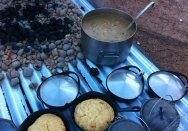

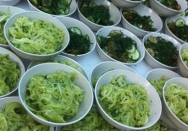
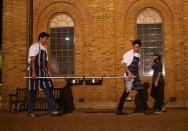




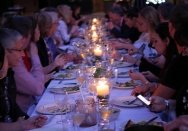
 Print recipe
Print recipe

